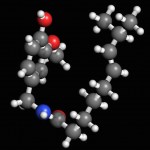receptor
New research shows how octopus skin is able to respond to variations in light
To have an effect, a molecule must bind to a receptor and trigger a signal. Studying a receptor's structure can give us insights about the way this triggering process works.
Capsaicin is a fascinating molecule that puts the "pep" into peppers. Curiously, the amount of capsaicin in a pepper is measured with a test devised in 1912 by Wilbur Scoville. Dried peppers are dissolved in alcohol, this liquid extract is diluted in water, and trained people determine the pepper's Scoville value by "tasting" the heat.
I wonder how these people are recruited.…
Yesterday was the final day of the meeting with many late breaking poster presentations as well as this year's Nobel Laureate lecture.
This year's American Physiological Society Nobel Prize in Physiology or Medicine Lecture was given by Dr. Robert J Lefkowitz from Howard Hughes Med. Inst. and Duke Univ. Med. Ctr. He was awarded the Nobel prize in Chemistry in 2012. What makes him famous is a tiny receptor located in the plasma membrane of cells called the G-protein coupled receptor. He is known for discovering the receptor for adrenaline (i.e. the fight or flight…
Alzheimer's disease is the most common form of dementia in the world, affecting more than 26 million people. Creutzfeld-Jacob disease (CJD), another affliction is far less common, but both conditions share many of the same qualities. They are fatal within a few years of diagnosis, they are incurable and they involved the crippling degeneration of the brain's neurons. Now, a group of Yale researchers have discovered that the two diseases are also linked by a pair of critical proteins.
Look into the brain of someone with Alzheimer's disease and you will see large, insoluble "plaques" sitting…

